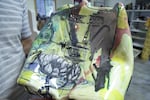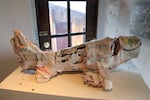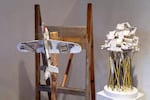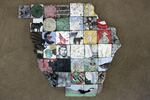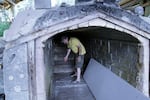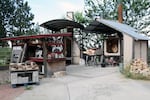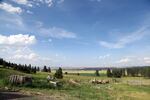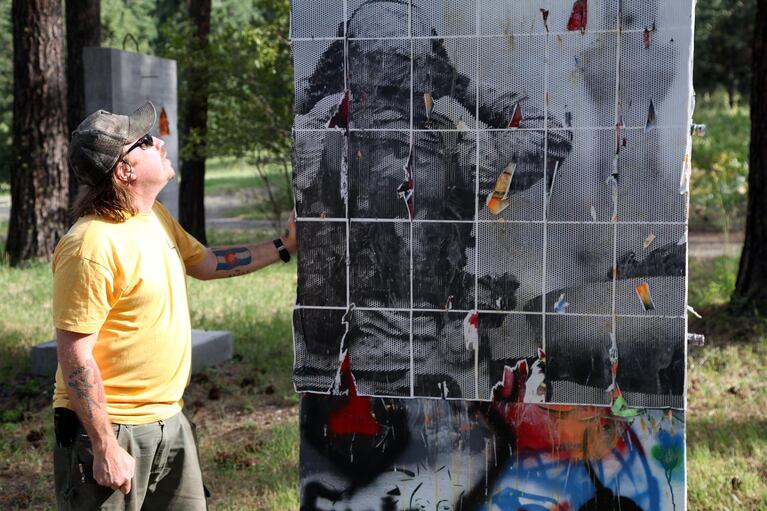
LH Project founder Jakob Haßlacher peers up at a Berlin Wall replica he made. It's a project he's returned to several times since 1989, when he was in Berlin during the wall's fall.
Aaron Scott / OPB
There are a lot of reasons to visit Joseph, Oregon, beginning with the spectacular Wallowa Mountains. But for ceramic artists, there’s one very specific reason: a residency program that some have called the Shangri-La of ceramics.
But the LH Project is not the mental image you might have of an artists’ residency. There are no glasses of merlot, no berets, no still lives of lilacs and persimmons. LH is pure rock ‘n’ roll clay-slinging that attracts artists from around the world, including a group of veterans who return year after year.
When I arrived, LH’s founder, Jakob Haßlacher, was giving a primer on his heavy duty military motorcycle to the artist Jesse Albrecht. Haßlacher had a handle bar mustache, Albrecht a big bushy beard.
“My wife has a brand new, pink mountain bike helmet,” Haßlacher said. “We have to get you with your shirt off and all your tats wearing the pink helmet, cruising around the property on this thing.”
The bike is built for anything. Its wheels can be filled with water or gas for long expeditions, or emptied and used to float across rivers.
“My parents said if I ever got a motorcycle, I would be disinherited,” continued Haßlacher. “They’re both dead — I’m an orphan. But it’s not a motorcycle; it’s called a motor tractor.”
The motor tractor is a fitting vehicle for Haßlacher. His love of ceramics has taken him across the continent. He got his start as a student at Lewis & Clark College and then spent time at the Oregon College of Arts and Craft. One of his teachers, Thomas Orr, finally told him to stop messing around with school and chase real-life experience, so Haßlacher packed his van and spent several years volunteering at ceramics residencies and centers.
“I thought I was just going to be a country potter,” he said of his return to Oregon. “I thought I’d build a little kiln, make pots and sell pots locally.”
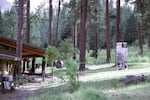
The original building at LH is made of straw bails and stucco. The land was off the grid when Haßlacher bought it.
Aaron Scott / OPB
Then he came across an old horse-packing ranch at the back of the Wallowa Valley, where the mountains tower above like granite titans. It was off the grid and the house was made of straw bales and stucco, but that just added to the appeal.
“It smells like northwestern Colorado,” he said. “It’s got that alpine air — the cow s--- coming from the fields. It smells like where I grew up as a child."
Haßlacher came into money after his grandmother died and bought the property in 2000. He named it LH after the cattle brand his family used at their ranch in Colorado.
Haßlacher started to build out the property, adding a house; studios for himself and his wife, the internationally successful sculptor Chris Antemann; and kilns of all sizes. Along the way, he reflected on all the artists he’d met at the residency programs he’d visited and how much he’d learned from them.
“I just thought, I have all this land,” he said. “I have all that it really takes to do a small residency program.”
He started out using his family’s money to offer artists housing, materials and a small stipend. Despite having now created a nonprofit and an LLC, he still operates with an intentional informality, accepting artists only by word of mouth.
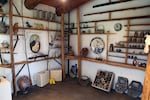
Now the original house serves as a gallery. As part of the residency, each artist leaves behind at least one work.
Aaron Scott / OPB
Now the original straw-bale house serves as a gallery of sorts filled with white plinths and a meandering lattice of live-edge wooden shelves. As a thank you, each artist leaves at least one work. Haßlacher shows me pieces that range from a mosaic of painted tiles recounting a massacre of Chinese laborers on the nearby Snake River to giant pots by the renowned Korean potter Lee Hun-Chung.
The Josephy Center of Arts and Culture in Joseph will have an exhibition of the LH Project’s permanent collection in October.
Residents stay anywhere from a couple weeks to a year. Some are world-renowned; others are promising graduate students. But one group of artists comes back year after year. They’re a group close to Haßlacher’s heart: military veterans.
“You just got to hear about these guys are coming back with horror stories and just not getting the attention and the love and the care that they need,” said Haßlacher, whose family has a long history of service.
In the sunny main studio at the center of the ranch, three vets were spread out at their own tables. The band Tool was cranked up on the stereo, and the Budweiser flowed more freely than the glaze.
“We wake up, we come out here, we crack a beer and we start working on art,” Daniel Donovan said to describe the typical day. “We put on music, we play it really loud and we just sort of go all day. Some of the evenings we head up to Jakob’s place and play a little bocci and BBQ. And then we hit the hay and you wake up early, because there’s no curtains in the barn, and the sun is up around 4:30 or 5.”
Donovan joined the military in 2001 and served eight years in Kuwait and Iraq. He was working on a series of sculptures in the shape of five-gallon government issue water cans, because that’s what a drill sergeant made a fellow recruit carry around as punishment for passing out from dehydration when he didn’t drink enough. They’re covered in paintings.

Artist and veteran Daniel Donovan painting one of his clay replicas of the millitary's standard-issue, five-gallon water can. This one has a painting of a boy scout holding a wooden gun. "A lot of my thesis work in graduate school now is dealing with constructs in society that help define aspects of masculinity," says Donovan.
Aaron Scott / OPB
“Specifically this piece right here, there's a boy scout on it,” he said. “I was in the scouts. A lot of my thesis work in graduate school now is dealing with constructs in society that help define aspects of masculinity. He has a wooden rifle — I was given a wooden rifle when I was 6. Just the idea that you would be given a wooden rifle at the age of 6 and introduced to weapons at such a young age and then indoctrinated into this uniformed, pseudo-military of the scouts, where you might be far more prone to seek that out at an older age.”
At a neighboring table, Jesse Albrecht was under-glazing a series of clay crocks.
“Because crocks used to be something that was a low-brow thing, that was not considered art — it was craft and was pooh-poohed,” he said of why he chose to work with the traditional forms. “And then for me, war is just a crock of s---. The myth of it, the idea of it, the reality of it.”
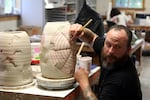
Jesse Albrecht painting one of his War Crocks. “Crocks used to be something that was a low brow thing, that was not considered art — it was craft and was pooh-poohed,” he said of why he chose to work with the traditional forms. “And then for me, war is just a crock of shit. The myth of it, the idea of it, the reality of it.”
Aaron Scott / OPB
Albrecht covers the crocks in paintings and the impressions of various weapons and toys he found at a dollar store. Inside some are ceramic piles of feces.
“I have these Marine action figures which have amazing detail, let's see, that's a M16A2 with a gangster grip on it and iron sites,” he said, holding up one of the toys from a bowl. “You've got backpacks, you've got pistols, knives, you have a 240 bravo. I like using them to then to show the reality of, oh, what it looks like when an IED goes off or what it looks like when somebody gets their arm blown off from a grenade. I'm definitely very literal. The idea is to make people uncomfortable. This is a Mardi Gras compared to what it's really like."
Albrecht was a graduate student at the University of Iowa when, as a national guard member, he was deployed to Mosul, Iraq, in 2003 — a place he’d only read about in art history books and the Bible.
He was trained as a medic, but he ended up manning guns in security convoys.
“So many people had to do jobs that they weren't trained or equipped for,” Albrecht said. “I didn't have the $200 — if that — ceramic inserts that would actually stop bullets in my vest, and I was in a ceramics graduate program in college, so that sweet sweet irony wasn’t lost on me. It also put a really bad taste in my mouth, that my life isn't worth $300 worth of clay. That's a pretty bitter pill to swallow.”
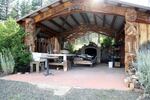
LH's Noborigama, or dragon, kiln is build into a hill. Firing it requires feeding the fire around the clock for several days.
Aaron Scott / OPB
Albrecht returned to the states after a year, having completed a number of years in the Guard. While visiting friends in Flagstaff, he ended up at a multi-day firing of a Anagama kiln. Two ceramicists there happened to be Vietnam veterans. They saw Albrecht drinking and spoiling for a fight and they took him under their wings and encouraged him to get help at the VA.
“Art, and specifically ceramics, is something that then pulled me back into the world here as a civilian,” he said. “That makes the hair stand up on my arms.”
One of the vets recommended Albrecht for a residency at LH. In talking with Albrecht, Donovan, and the third veteran, Guiseppe Pellicano, it’s clear that they get something beyond just space and time to work at LH. They say that, in other settings like school, folks don’t feel comfortable criticizing the work of veterans. Or perhaps worse, they talk about it as therapy art. Not so with other vets at LH.
“We know all the other stuff that goes up to it that we don't have to tiptoe around,” said Albrecht on the porch. “We can just talk frankly about the work in a way that's just strictly art.”
“There’s something about the raw energy in their work that’s unparalleled to the other artists that we get out here,” Haßlacher concurred. “Something that I’m really blessed to see.”
Haßlacher hopes the veteran’s work can one day tour nationally. As for the future of the LH Project, Haßlacher’s happy to keep it small and intimate: just a couple of potters in the country.


